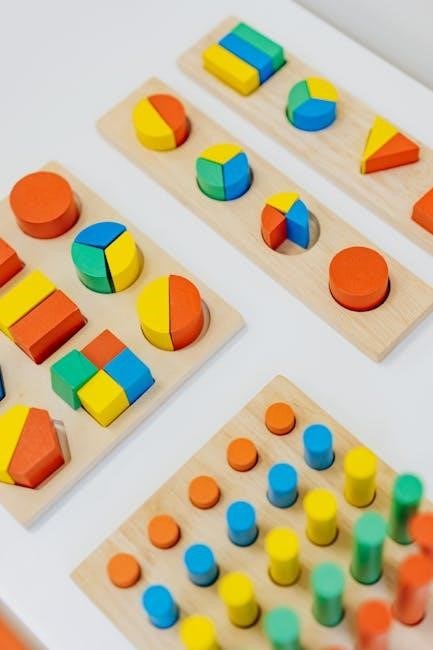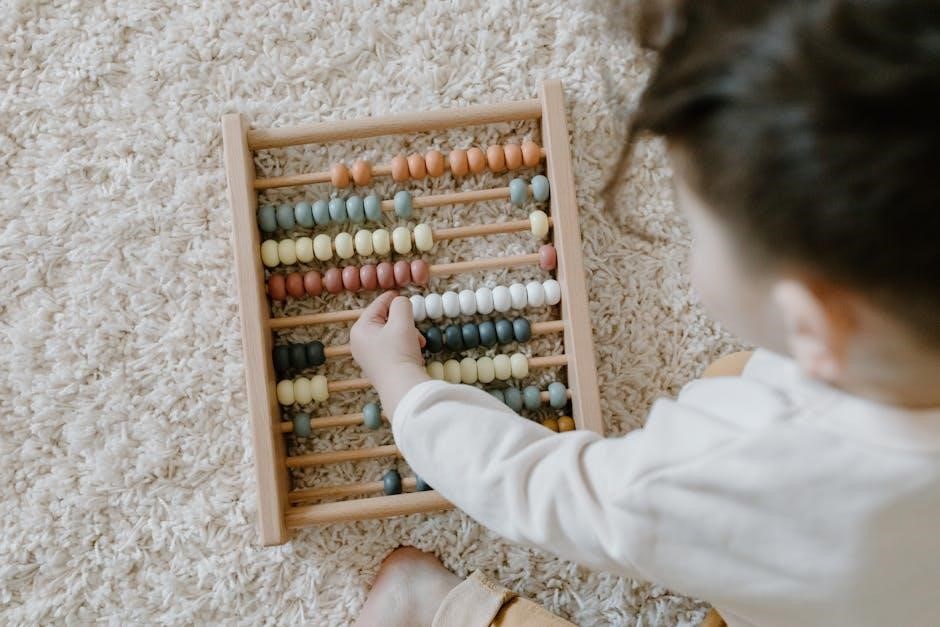Math Activities for 3-5 Year Olds: A Comprehensive Guide with PDF Resources
Pre-K math activities lay the groundwork for future math skills, fostering number sense and counting. Engaging activities cultivate a positive attitude towards math. Discover fun preschool math printables that teach basic math skills preparing children for kindergarten.
Pre-K math introduces fundamental concepts to young learners, setting the stage for future mathematical understanding. Hands-on activities and engaging worksheets make learning enjoyable and effective. These activities help children develop number recognition, counting skills, and basic math concepts. By engaging in fun math activities, children can develop a positive attitude toward mathematics. Worksheets and games are colorful and appealing to young learners. Each sheet can serve as a test paper for use in homeschooling kids or in the classroom for extra practice.

Essential Math Concepts for Preschoolers
Preschool math involves number recognition, shapes, patterns, and basic arithmetic. Worksheets and hands-on activities introduce counting, sorting, and measurement. These fundamental concepts build a strong math foundation. Early exposure makes learning an exciting adventure for kids.
Number Recognition and Counting (1-20)
Introducing numbers 1 through 20 is crucial for preschoolers. Use number cards and engaging activities to enhance recognition. Games with dalmatians and matching numbers to quantities can be effective. Hands-on activities with blocks or LEGO bricks reinforce counting skills. Printable worksheets offer practice in number tracing and formation. Activities with colorful images and interactive content can make learning fun. Incorporate counting during playtime and daily routines to reinforce number sense. Math worksheets are printable sheets with exercises and questions related to different math topics, and they can be incredibly useful for helping children to practice their math skills.
Shapes and Geometry
Introduce basic shapes like circles, squares, triangles, and rectangles through hands-on activities. Shape recognition helps children develop mathematical communication skills. Engage students with sensory activities to learn about basic shapes. Utilize farm shapes game for interactive learning. Shape hopscotch is a fun way to recognize and name shapes. Pre-k math activities covered here include shapes and geometry, comparing objects, counting tally marks, patterns, positions /spatial sense and more to discover. Printable worksheets for identifying shapes offer extra practice. Encourage exploration of shapes in everyday objects to reinforce understanding. Using an engaging read-aloud, your students will learn all about the concept of comparison in math.
Patterns and Sorting
Develop pattern recognition with colorful objects, using AB and ABC patterns for variation. Sorting activities can involve colors, shapes, or sizes. These are hands-on ways to gently introduce math concepts for preschool. Utilize pattern cards to help with this. The first page is an AB pattern, meaning two colors alternate in the pattern. The second page is an ABC pattern, meaning three are three colors in the pattern. Worksheets for sorting and patterns are available. Engage children in sorting toys or household items to reinforce the concept. Pattern activities enhance problem-solving skills. You can sort, count, or use them with patterns.
Basic Addition and Subtraction
Introduce basic addition and subtraction using hands-on activities and visual aids. Use objects like blocks or counters to represent numbers. Start with simple problems, such as adding one or two to a small number. Worksheets offering simple addition and subtraction problems are useful. Engage your child in counting, number recognition, basic addition and subtraction. For subtraction, take away objects from a group and count what is left. These colorful, engaging activities make learning an exciting adventure for kids. Incorporate stories or real-life scenarios to make it relatable. These activities help children develop mathematical communication.
Measurement and Comparison (More/Less)
Introduce measurement and comparison using everyday objects. Compare the sizes of toys, books, or blocks, using terms like “more” or “less.” Use different sized buckets. Teach children about the concept of comparison in math. Ask questions such as “Which one is bigger?” or “Which one has fewer?” Use comparison worksheets. Activities could include comparing which group has more or less items. Engage your child in activities relating to measurement. Hands-on exploration is key for preschool children. These activities help children develop mathematical communication. Teachers should maintain an environment that nurtures exploration. Use toys and blocks of different sizes.

Hands-On Math Activities
Engage preschoolers with tactile math activities. Use blocks and cubes for counting games. Create patterns with colorful objects. Play shape hopscotch to recognize shapes. Hands-on activities make learning fun and concrete. Use blocks, LEGO bricks, or Unifix Cubes.
Counting Games with Cubes and Blocks
Counting games with cubes and blocks are a fantastic way to introduce early math concepts. Give students a pair of dice and blocks. Students roll one die and build a tower with that number of blocks or cubes. This hands-on approach helps children visualize numbers and quantities. It fosters one-to-one correspondence and strengthens number recognition. This is a great way to get a feel for math. Utilize blocks, LEGO bricks, or Unifix Cubes to make learning interactive and enjoyable.
Pattern Creation with Colorful Objects
Engage preschoolers with pattern creation using colorful objects like blocks, beads, or buttons. This activity introduces the concept of patterns in a fun, visual way. Start with simple AB patterns, alternating two colors. Then, progress to ABC patterns, using three colors. You can sort, count, or use them with patterns. Create pattern cards to help with this. This encourages problem-solving skills and enhances their understanding of sequencing. Hands-on experience with patterns builds a strong math foundation.
Shape Hopscotch
Create a shape hopscotch grid using sidewalk chalk or tape indoors. Draw various shapes like circles, squares, triangles, and rectangles. Call out a shape, and have the child hop to it. This activity combines physical activity with shape recognition. Recognizing and naming shapes helps children develop mathematical communication. It enables them to accurately share their ideas. This game reinforces shape identification in a dynamic, memorable way. Shape hopscotch is a fun way to promote shape learning.

Utilizing PDF Worksheets for Math Practice
Free PDF worksheets offer structured practice. These reinforce early math skills in a fun, engaging way. Worksheets cover counting, number recognition, shapes, patterns, and basic addition. They provide extra teaching material for teachers and practice for kids.
Free Printable Worksheets for Number Tracing
Number tracing worksheets are a fantastic way to introduce number formation. They help children learn to write numbers correctly and reinforce number recognition. These worksheets often feature large, clear numbers with dotted lines. Children can practice tracing over these lines to develop fine motor skills. This activity makes learning to write numbers an exciting adventure for kids. The best graphics and colors appeal to young learners. These worksheets help kids to practice writing and counting numbers. They are suitable for preschoolers and kindergartners.
Worksheets for Identifying Shapes
Identifying shapes is a foundational math skill for preschoolers. Worksheets focused on shape recognition help children distinguish between different geometric forms. These worksheets often include activities like matching shapes, coloring shapes, or identifying shapes in everyday objects. Students will learn all about basic shapes! These worksheets are visually appealing, filled with colorful images, and interactive activities; Recognizing and naming shapes helps children develop mathematical communication and enables them to accurately share their ideas.
Worksheets for Basic Addition and Subtraction
Introducing basic addition and subtraction through worksheets provides a structured approach to early arithmetic. These worksheets typically use pictures or simple scenarios to illustrate the concepts. Students practice adding or subtracting small numbers (1-5) with visual aids. These free printable worksheets are to help Preschool, Pre-k and Kindergarten aged kids to understand simple addition. Each math worksheet has an answer sheet attached, making it easy for teachers and parents to use. These worksheets cover a range of essential math concepts in a fun and engaging way.

Integrating Math into Daily Activities
Math is used every day to tell time, to play games, cook, build, and do almost any kind of work. Use everyday activities that naturally develop mathematical knowledge. They will help children develop vital life skills.
Counting During Playtime
When children show signs of readiness, introduce math concepts playfully. Incorporate math while playing with cubes, blocks, or LEGO bricks. Students can roll a die and build a tower with that number of blocks. Sort toys and count them as they are put away. Make four elbows by forming a circle. The children begin slowly walking in one direction. Use games to assist preschool teachers enacting differentiated teaching and learning. Maintain important learning objectives.
Using Math in Cooking
Incorporate math into everyday activities like cooking, as everyone uses math daily. Have children measure ingredients while baking, counting cups of flour or spoonfuls of sugar. Use different-sized buckets for measuring and comparing quantities. This can help them understand measurement and comparison concepts such as more or less. Discuss sizes, measures, and measurements. This provides vital life skills. Engaging in these activities helps children develop early years counting and problem-solving skills. Cooking provides a practical context for learning math.
Math During Story Time
Integrate math into story time by selecting books that focus on counting, shapes, or patterns. While reading, pause to ask questions like, “How many animals do you see?” or “What shape is the character’s house?” This encourages active listening and mathematical thinking. Use books to introduce comparison concepts, asking which object is bigger or smaller. This encourages mathematical communication. These activities support differentiated teaching and learning. Also, use math nursery rhymes to make math fun and exciting for young children.
Resources for Printable Math Activities
Explore Teachers Pay Teachers for free and paid resources. Mathskills4kids.com offers premium, original math activities. The Math Learning Center provides practice books. These resources provide downloadable PDF worksheets, enhancing early counting and number writing skills, perfect for preschoolers;
Teachers Pay Teachers
Teachers Pay Teachers offers a wide array of printable math activities suitable for preschoolers and kindergartners. A notable resource is a free downloadable PDF designed to enhance early counting skills in an engaging way. This workbook features illustrated pages where students count objects and practice number writing. It provides interactive content suitable as a math center activity. Many free, fun math worksheets are available online, perfect for children practicing math skills. They support number tracing, counting, basic addition, subtraction, patterns, and shapes.
Mathskills4kids.com
Mathskills4kids.com is a premium website providing original math activities and resources for practice. They offer free resources for kids from preschool to grade 6, improving skills in various mathematical areas. The site focuses on visually appealing, colorful, and interactive worksheets, making learning an exciting adventure. Worksheets cover counting, shapes, geometry, comparisons, patterns, and spatial sense. When selecting math worksheets, consider their visual appeal and interactivity. The platform ensures user privacy and doesn’t share identifiable information with third parties.
The Math Learning Center
The Math Learning Center offers resources such as the Bridges in Mathematics Kindergarten Practice Book Blacklines. These materials provide practice with key skills aligning with the Bridges in Mathematics curriculum. Activities support differentiated teaching, maintaining learning objectives for individual students. Teachers should foster exploration, nurturing mathematical learning through engaging environments. Activities may include recognizing shapes, developing mathematical communication skills, and sharing ideas accurately. These resources are suitable for preschool, pre-k, and kindergarten-aged children, helping them understand simple addition and identify numbers effectively. These activities help develop early counting, problem-solving, and number skills.
